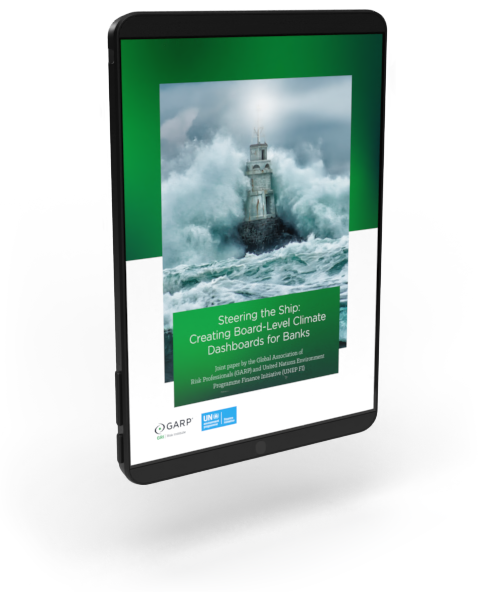Steering the Ship: Creating Board-Level Climate Dashboards for Banks
July 12, 2022
As climate change risks increase worldwide, company boards will be critical in ensuring their firms remain resilient and on a path to carbon neutrality. Developed from insights and interviews with 50 top financial institutions, this collaborative report from GARP and the United Nations Environment Programme Finance Initiative (UNEP FI) provides banks with a comprehensive framework for creating decision-useful, board-level climate dashboards.
Featuring high-level and detailed examples of dashboards — both hypothetical and from published reports — the paper covers the 'what, why, and how' of creating a climate dashboard, answering key questions such as:
-
What is the board's role in managing climate risk?
-
How should an effective climate dashboard be structured — and what types of information should be included?
-
What are the key climate metrics that bank boards should see?
-
What are some of the challenges banks are currently facing in creating these dashboards?
Key Takeaways
-
Climate risk is increasing, and boards will need to steer their companies through an increasingly complex climate and sustainability landscape.
-
Climate governance can be aided by a well-designed climate dashboard, which will bring together useful information to support decision-making processes over the coming years.
-
Banks have a range of stakeholders who will be focused on their climate awareness, including supervisors, investors, non-governmental organizations (NGOs), and society in general.
-
If a bank wants to understand whether climate risk is within its risk appetite, it needs to assess the potential risk to industry sectors, counterparties, or transactions that are expected to have a material exposure to climate risk.
-
There is no one-size-fits-all for creating a climate dashboard. The information that is relevant will depend on the institution, its size and complexity; the type of lending it does; the location of its counterparties and their collateral; and the bank’s level of ambition and sophistication.
About the authors
Jo Paisley, President of the GARP Risk Institute, has worked on a variety of risk areas at GARP Risk Institute, including stress testing, operational resilience, model risk management and climate risk. Her career prior to joining GARP spanned public and private sectors, including working as the Director of the Supervisory Risk Specialist Division within the Prudential Regulation Authority and as Global Head of Stress Testing at HSBC.
Maxine Nelson, Senior Vice President, GARP Risk Institute, currently focuses on climate risk management. Previous roles have included operational risk modelling at NAB, leading KMPG London’s credit risk team, senior consultant at Oliver Wyman, responsibility for counterparty credit risk at the UK Financial Services Authority, and Global Head of Wholesale Risk Analytics and Head of Capital Planning at HSBC.
Contributors from UNEP FI
David Carlin, Climate Risk and TCFD Lead
Hina Majid, Senior Expert, TCFD Program
Lea Lorkowski, UNEP FI

Want to read more?
Download the full report now!